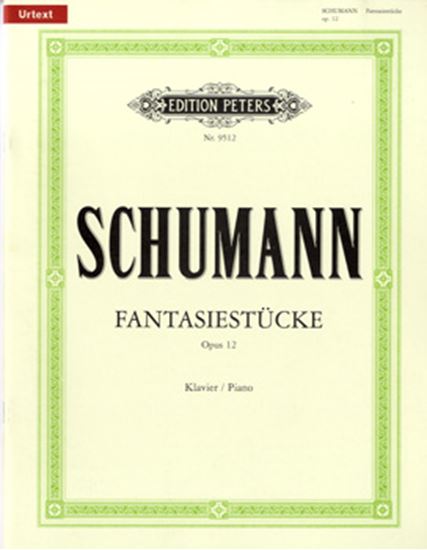Schumann, Robert : Phantasiestüke Op.12
Work Overview
Publication Year:1838
First Publisher:Breitkopf und Härtel
Instrumentation:Piano Solo
Genre:pieces
Total Playing Time:28 min 00 sec
Copyright:Public Domain
Commentary (1)
Author : PTNA Piano Encyclopedia Editorial Department
Last Updated: January 1, 2010
[Open]
Author : PTNA Piano Encyclopedia Editorial Department
This collection consists of 8 pieces, composed in 1837, and each piece has a descriptive title.
Phantasiestücke Op. 12-1 "Des Abends" (Evening)
This opening piece is written in D-flat major, a key most effective for piano music. Both the melody and structure are extremely simple, with the same motif repeated in a detached manner, yet from this, an evening scene is evoked, making one forget the passage of time and linger. The instruction "Sehr innig zu spielen" (to be played very intimately/heartfeltly) suggests Schumann's deep affection for twilight, much like many Germans.
Phantasiestücke Op. 12-2 "Aufschwung" (Soaring)
The powerful opening theme and the light theme that appears after a shift to a major key evoke a free and powerful flight of imagination and fantasy. It is frequently performed as a standalone piece.
Phantasiestücke Op. 12-3 "Warum" (Why)
This third piece begins with a dominant seventh chord from the outset, as if posing a poignant question. However, the responding inner voice is weak, and the next question begins without waiting for its conclusion. Rather than a passionate cry from the heart, it is a piece that seems to earnestly question one's inner self with a sigh.
Phantasiestücke Op. 12-4 "Grillen" (Whims)
The instruction for this fourth piece is "Mit Humor" (with humor), but German humor is unique. Perhaps it can be described as a certain comicality arising from being overly serious, rather than being conscious of others. The opening section of this ternary form consists of two themes: first, a very serious and ponderous chord progression, and in the next part, a clumsy chordal rhythm seems to interject against the flowing melody in the upper voice. The middle section, characterized by somewhat indistinct back-and-forth motion of second intervals (common in other pieces as well), progresses as if questioning one's inner self, making it an interesting piece that aptly depicts the constantly shifting moods suggested by its title.
Phantasiestücke Op. 12-5 "In der Nacht" (In the Night)
Throughout, sixteenth notes flow in a surging manner, creating intense tension, giving the impression not of a quiet night, but of a stormy night or a nightmare. In the opening section of this ternary form, diminished seventh chords frequently appear, and in the middle section, it shifts to a major key, seemingly calming down, but the accompaniment still uses minor second intervals as non-harmonic tones, creating tension. It is the longest piece in the collection and is likely positioned as the core of the entire work, being the fifth piece.
Phantasiestücke Op. 12-6 "Fabel" (Fable)
While "Fabel" might be a slightly ambiguous Japanese title, it essentially refers to a "fairy tale"—a story not based on reality. This is also in ternary form. The remarkably simple four-bar melody, also in C major, gives a very innocent and pure impression. In contrast, the sixteenth-note motif has accents placed on weak beats at key points, making it seem like an innocently bouncing child. The middle section shifts to a minor key, and a melody emerges from repeated chords. The ascending passages in both hands are somewhat elusive, reinforcing the idea that this was indeed a "fable."
Phantasiestücke Op. 12-7 "Traumes Wirren" (Dream's Confusions)
This is the seventh piece in the eight-piece "Fantasiestücke" collection, written in 1837. It is a bright, light, and etude-like piece. The middle section is played with chords, but the rest of the piece is characterized by intricate sixteenth-note figures.
Technically, there are many passages where the 4th and 5th fingers of the right hand move alternately, making it extremely difficult to play. For this reason, the title "Traumes Wirren" (Dream's Confusions) is sometimes ironically referred to as "finger tangles" or similar. Nevertheless, it is a captivating piece where dreams vividly intertwine, making it very frequently performed as a standalone work.
Phantasiestücke Op. 12-8 "Ende vom Lied" (End of the Song)
In contrast to the preceding piece, which has strong technical elements, this piece is consistently melodic throughout and supported by symphonic sonorities created by chords. After a return following an impressive middle section with chromatic progression, the piece seems to end, but then a somewhat long coda follows. The theme is played reminiscently at a soft dynamic, and the piece quietly concludes as if falling asleep.
Movements (8)
PTNA & Partner Channel Videos(22items) View More
Reference Videos & Audition Selections(5items)
Sheet MusicView More
Scores List (48)

(株)全音楽譜出版社

KMP(ケイ・エム・ピー) ケイエムピー

(株)音楽之友社

(株)春秋社

(株)全音楽譜出版社

(株)全音楽譜出版社

(株)全音楽譜出版社

(株)ヤマハミュージックエンタテインメントホールディングス

(株)音楽之友社

(株)リットーミュージック

(株)ヤマハミュージックエンタテインメントホールディングス

カワイ出版

ハンナ(ショパン)

ハンナ(ショパン)

ハンナ(ショパン)

ハンナ(ショパン)

ハンナ(ショパン)

(株)全音楽譜出版社

(株)音楽之友社

(株)音楽之友社

ヘンレ社(ヤマハ)

(株)音楽之友社

Breitkopf & Hartel

Breitkopf & Hartel

Breitkopf & Hartel

Breitkopf & Hartel

Breitkopf & Hartel

Breitkopf & Hartel

Breitkopf & Hartel

Breitkopf & Hartel

Breitkopf & Hartel

Breitkopf & Hartel

Breitkopf & Hartel

Breitkopf & Hartel

Breitkopf & Hartel

Breitkopf & Hartel

Breitkopf & Hartel

Breitkopf & Hartel

Peters

Peters

Peters

Peters

(株)ヤマハミュージックエンタテインメントホールディングス

























